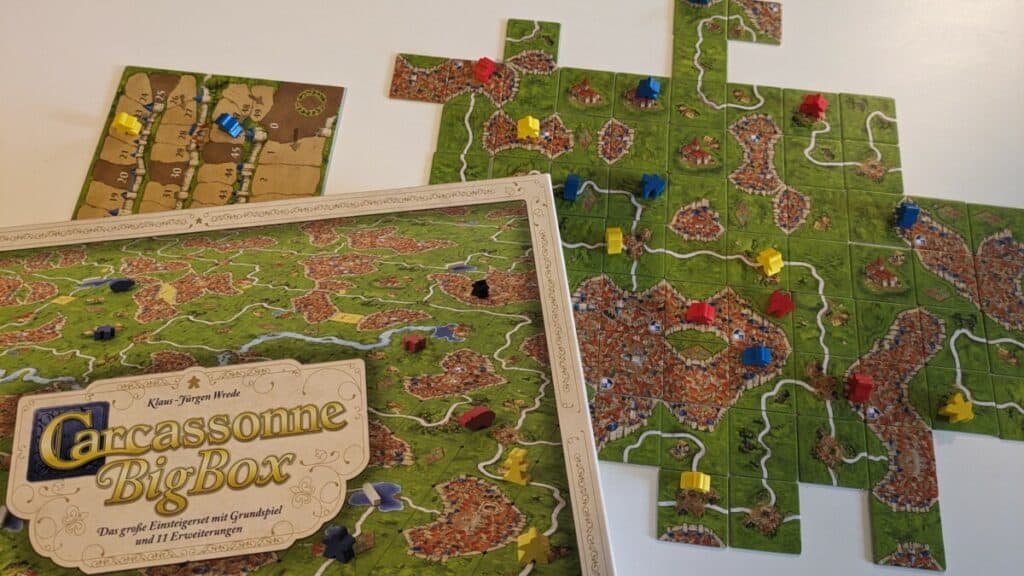
Carcassonne is an absolute classic of a board game and, in my opinion, it is one of the best strategy games ever made. It’s relatively simple but has endless replayability and tons of expansions to keep things fresh. Carcassonne is one of my favorite games to play with my family so naturally I’ve learned every strategy possible to increase my chances of winning. These Carcassonne strategies are sure to improve your game as well.
In general, the best Carcassonne strategies are to effectively manage farmland, force other players to build features for you, and share features with opponents. You should also try to outright steal large features from opponents and manage your Meeples based on the size and phase of the game.
Every game of Carcassonne is different, which is what makes it so fun. Each of the strategies outlined below can and should be implemented in your games, but some will be more effective than others based on how the game unfolds. I’ll go into the ‘why’ and ‘how’ of these strategies so that you can win Carcassonne more often.
Build up your farmland for more points
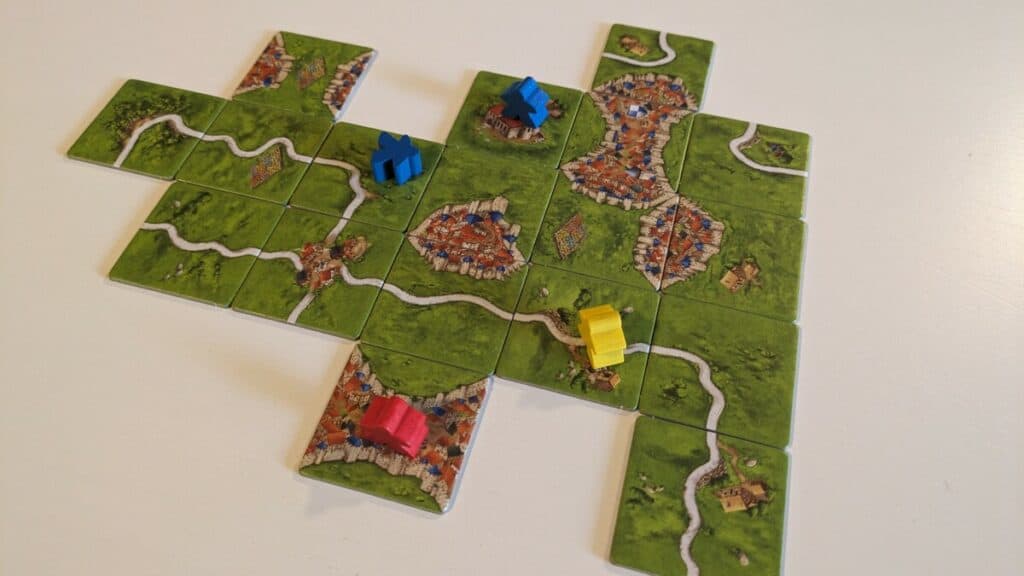
One of the most common and powerful strategies in Carcassonne is ‘farming’. This refers to the practice of placing a Meeple in a section of farmland and then deliberately expanding that farmland to include many small cities, earning a great deal of points.
This general strategy is well known, but many players don’t know how to implement it effectively. You want to do your best to keep your farmland clear of roads, large cities, and rivers. This gives you more opportunities for expansion and connects more farmland to your farmer.
CHECK IT OUT: If you love Carcassonne you’ll love all the expansions, too! You can buy them all individually or save some money and do what I did – just buy the Big Box Set (link to Amazon) that comes with 11 expansions to try!
Try placing farmers around Monasteries, which are predisposed to gathering farmland tiles around them. Any time you get a tile with one city edge, try to place it in your farmland with the intention of completing it as soon as possible. This will give you 4 points immediately for completing the city and 3 points at the end of the game, for a total of 7. This is a great return on your limited investment of tiles, turns, and meeples.
You should also always be on the lookout for valuable unclaimed farmland, especially at the end of the game. If you can find a farmland that will net your 6 or 9 easy points near the end of the game this is usually the most bang you’ll get for your buck.
Use roads to build and protect farmland

When using the ‘farming’ strategy, you’ll want to do your best to keep your farmland clear and unobstructed by roads. Other players will sometimes try to combat this, but they are often too busy with their own plans to do it effectively.
Use any road tiles that you draw to steer roads away from your farmland. This simultaneously expands your farmland and makes it more difficult for opponents to steer it back around into your territory. Similarly, if your opponents are creating valuable farmland you should try to cut through it with roads and large city tiles to limit their expansion.
Choose where you sit to get more turns
This is more of a meta-strategy, but I’ll take anything I can get if it improves my chances at winning! In the base version of Carcassonne there are 71 tiles (72 including the start tile). Since the game ends when the last tile is drawn and played, players will get a different number of turns.
Based on the number of players in the game, you can choose to sit in a chair around the table which will give you an extra turn compared to some other players. The rules of Carcassonne state that the youngest player goes first, so you can use that as an anchor point when choosing your spot. In general, you want to sit as close to the immediate left of the youngest player as you can.
| # of Players | Player 1 | Player 2 | Player 3 | Player 4 | Player 5 | Player 6 |
|---|---|---|---|---|---|---|
| 2 Players | 36 | 35 | ||||
| 3 Players | 24 | 24 | 23 | |||
| 4 Players | 18 | 18 | 18 | 17 | ||
| 5 Players | 15 | 14 | 14 | 14 | 14 | |
| 6 Players | 12 | 12 | 12 | 12 | 12 | 11 |
If you’re playing with the River expansion, the math changes a bit. There are 71 tiles from the base game and 12 additional River tiles, for a total of 83. You can see how many turns each player will get on the chart below:
| # of Players | Player 1 | Player 2 | Player 3 | Player 4 | Player 5 | Player 6 |
|---|---|---|---|---|---|---|
| 2 Players | 42 | 41 | ||||
| 3 Players | 28 | 28 | 27 | |||
| 4 Players | 21 | 21 | 21 | 20 | ||
| 5 Players | 17 | 17 | 17 | 16 | 16 | |
| 6 Players | 14 | 14 | 14 | 14 | 14 | 13 |
Let other players build cities for you
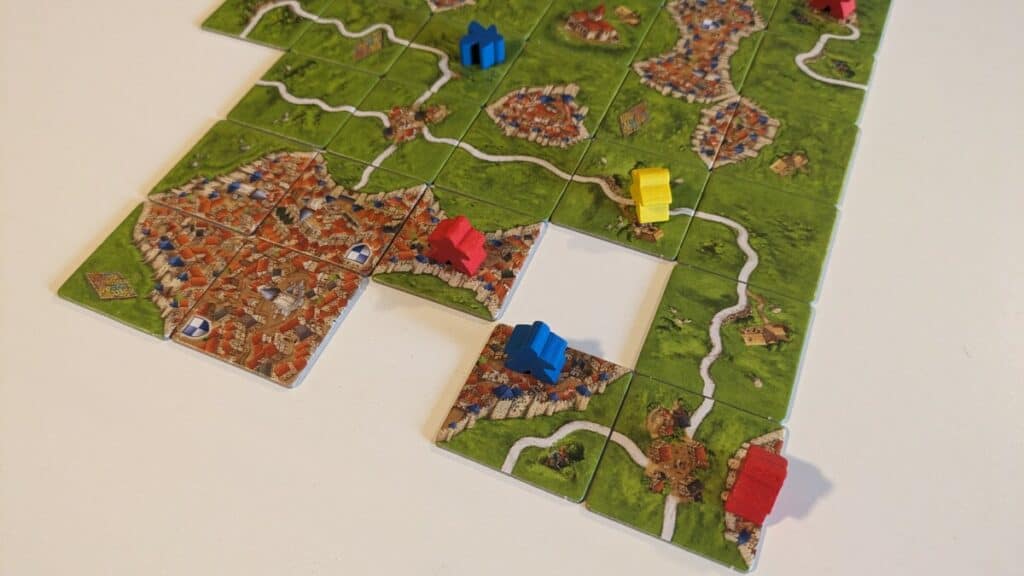
One of the most ruthless (and entertaining) strategies in Carcassonne is moving in on a city that other players have spent many turns building. If you can manage it, it’s a great way to get a leg up on your competition because you haven’t spent the time and resources building the city – you’ve let your opponents do it for you!
Try to place a city tile close to a large city that an opponent has been working on and then claim it with a Meeple. Then, on a subsequent turn, you can hopefully connect the two city segments so that you get an equal share of the city points. Even better, do this multiple times and lay claim to the city entirely!
Ruin the layout of other players’ cities
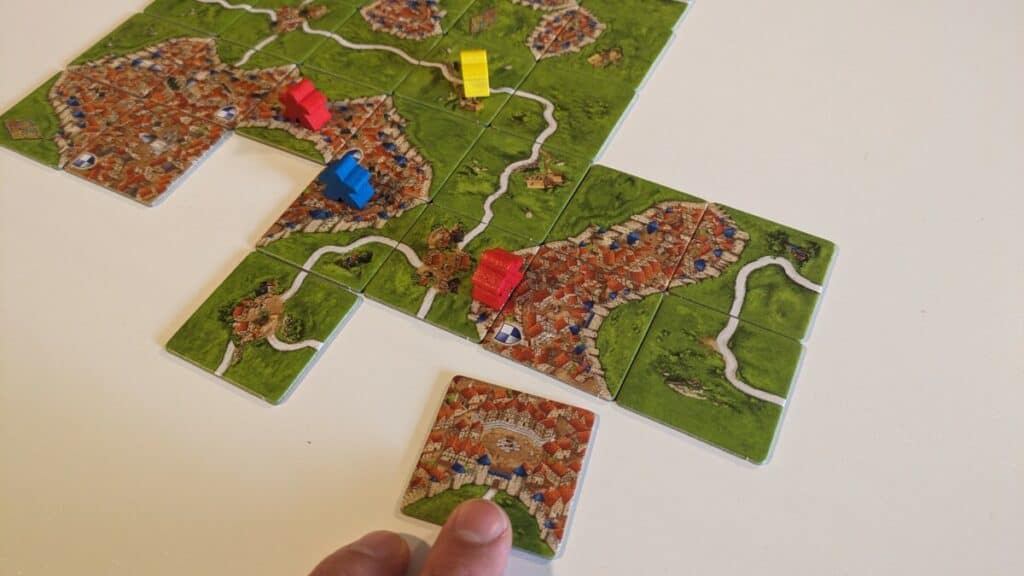
If you can’t share (or steal) a large city from an opponent then you can likely prevent them from completing it. This strategy becomes more effective the larger the city gets because you are preventing the points from more city tiles being doubled. If your opponent has a very large city going then you should make this a top priority.
You can ruin the layout of a city by adding problematic features in or around it. Try to create gaps that are difficult (or even impossible) to fill. This strands your opponent’s Meeple and denies them a lot of points.
Some players are hesitant to add a city tile to an opponent’s city, but this is a perfectly viable strategy if it means the city becomes harder to complete. This is especially true near the end of a game when players have fewer turns left. It’s worth it to give your opponent 1 point from an additional city tile if it means they can’t complete the city and get an extra 10 points.
Complete your cities whenever possible
A common mistake that Carcassonne players often make is trying to build very large cities. These large cities become targets for other players to share or steal and they become harder to complete as their borders grow larger and larger.
Cities don’t scale in Carcassonne. You don’t get any bonus points per tile for a larger city compared to a smaller city. For this reason, you should almost always choose to complete a city when given the chance, bank those points, and get a Meeple back. Possible exceptions include when your city is in someone else’s farmland.
Cooperate with players to share points
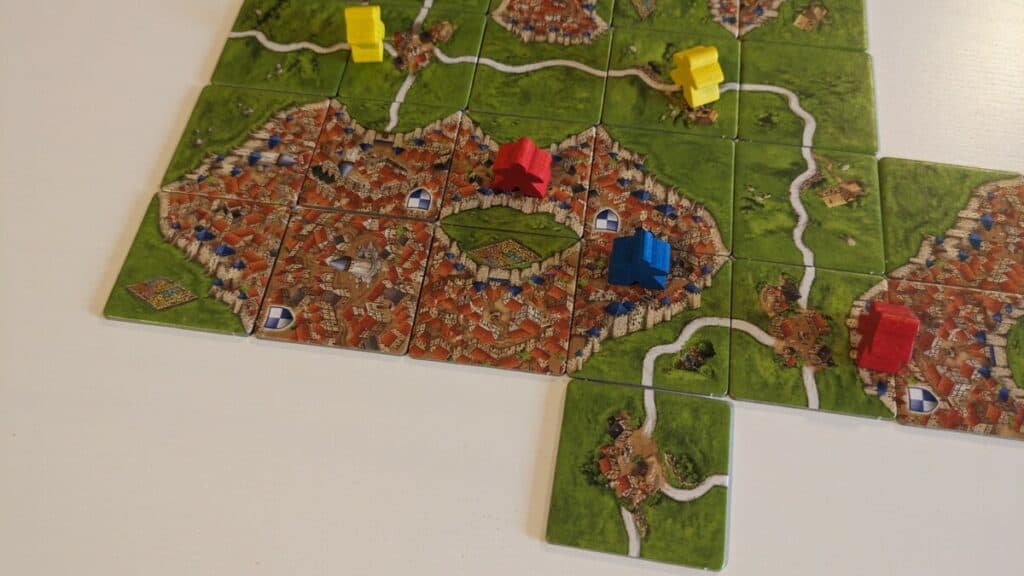
In games with more than 2 players, it is to your advantage to cooperate with other players on larger features since you can both get points from it. If you do this with multiple players on several features then you’ll come out ahead because other players are left out of the cooperation. Just make sure that you come across as friendly while doing this so that you aren’t viewed as hostile.
In a two-player game, this strategy goes out the window. You’re either trying to obstruct, share, or steal each other’s features. In a case where you are both sharing a feature, it isn’t worth it to use your tiles to add to the feature because you both benefit from it. Use your tiles to increase your advantage somewhere else on the board and let your opponent continue to build on the shared feature if they so desire.
Claim farmland toward the center of the table
Claiming farmland at the beginning of the game is a high-risk, high-reward strategy so you want to play the odds and give yourself the best chance of success. In general, try to claim farmland towards the center of the table where players are more likely to play. Of course, you also want to maximize the amount of green farmland branching out from your chosen tile.
CHECK IT OUT: If you like strategic tile-laying games, be sure to check out my Complete Strategy Guide to Kingdomino.
Players have a natural tendency to play toward the center of the playing table to keep things balanced-looking and not have to move all of the tiles to accommodate the game if it reaches the edge of the table. Good players won’t let this tendency affect their decision-making, but most players will let it have at least a subconscious effect on their play.
By claiming farmland that is more centrally located, you are more likely to end up with expansive farmland that touches a lot of completed cities.
Keep a Meeple in reserve for a Monastery

There is probably no worse feeling in Carcassonne than drawing a Monastery and having no Meeple to claim it with (okay, other than having a large city stolen out from under you). For this reason, you should always try to keep at least one Meeple in reserve in case you draw a Monastery on your turn.
Monasteries are usually the most valuable tiles in the game. Losing out on the opportunity to claim one can be a game-losing mistake. There are 6 Monasteries in the base version of Carcassonne, so you can keep track of how likely it is that you’ll draw one. If all of the Monasteries have already been played then there is less incentive to hold your Meeple.
Diversify your Meeples over various features
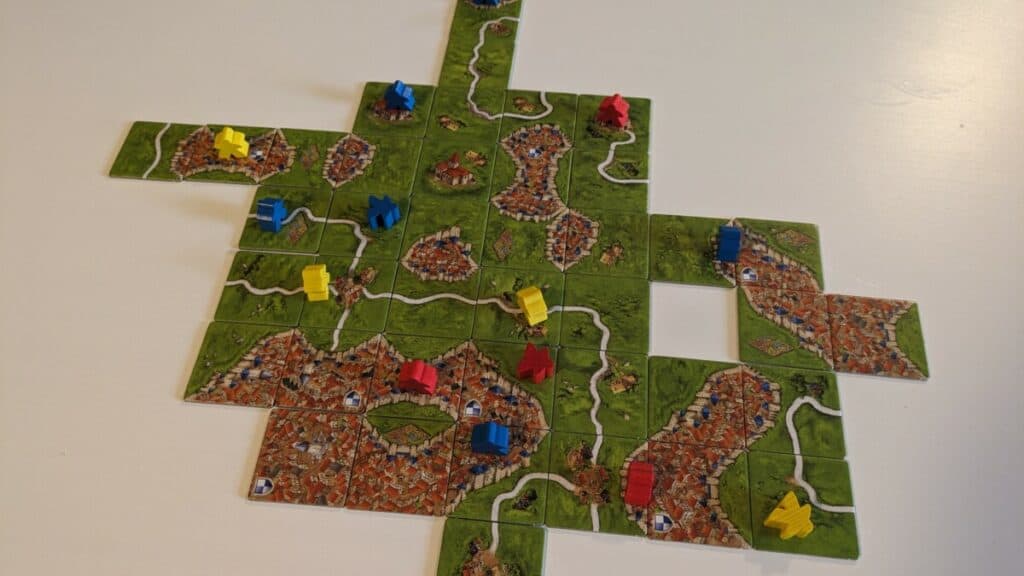
A good general strategy in Carcassonne is to keep your Meeples diversified over several features – preferably of different types. Try to always have at least one Meeple each in a growing city, a road, in farmland, and on a Monastery.
By having a Meeple on each type of feature you will almost always be able to contribute meaningful points no matter what tile you draw. You’ll need to adapt to the game as it comes to optimize those points, but at least you’ll always have options. Ideally, these Meeples are also coordinating together towards an overall strategy.
An ideal Carcassonne setup would look something like this:
- A Farmer on a large piece of farmland
- A Knight in a large growing city on the edge of that farmland
- A Highwayman on a long road at the periphery of the farmland
- A Monk on a Monastery near other growing features
Conserve Meeples in games with 2 or 3 players
In games with only 2 or 3 players you will get more turns than in games with more players (see above for exact numbers). This means that you need to be more conservative with your Meeple management because it’s easy to end up with lots of stranded Meeples on incomplete features.
It’s always nice to have a few Meeples in reserve to take easy points as they become available, or to seize an opportunity to snake away a feature from another player. Concentrate on growing and completing features that you already have Meeples on instead of starting new features.
The other side of this coin is that you should be more aggressive with your Meeple placement in games with more players. For example, in a game with 6 players, you’ll likely only get 12 turns in a base version of Carcassonne. You only have 7 Meeples to place, so you can probably place a Meeple on almost every turn if you’re completing features regularly.
Prioritize your own points over denying opponents
It’s easy to become vindictive in Carcassonne, especially in very competitive games. However, it’s often better to focus on building up your own points instead of obstructing your opponents.
In games with more than two players, it’s always nice if your opponents fight amongst themselves and leave you to your own devices. Try to come across as the neutral third party, doing your own thing while they fight over features.
Even in a two-player game, it is often best to build your own features instead of messing with your opponent. If you and your opponent each have cities of roughly equal size and you draw a city tile, it’s probably smart to complete your own city rather than ruining theirs. Your opponent isn’t guaranteed to draw a suitable city tile, so you might have a chance to play the spoiler on the next turn.
Place Monasteries next to opponents’ features
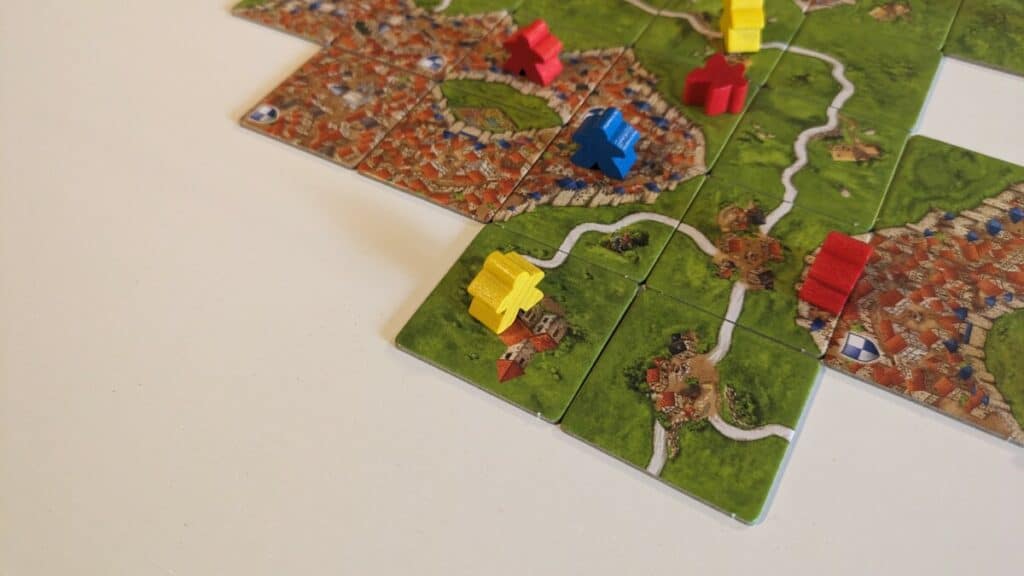
There is a running theme in these Carcassonne strategies, and that is to let other players do your work for you. This is again the case with Monastery tiles, which grant you a point for every surrounding tile. Monasteries are very valuable but filling in all of those tiles by yourself would take a total of 9 turns. Not great!
When placing a Monastery, look for locations that already have quite a few tiles around them and are also likely to be expanded on in the near future. Putting a Monastery next to an opponent’s large city is a perfect choice because you’ll get more points as they expand around it.
Take any points when they’re available
Another advantage of having a few Meeples held in reserve is being able to take small batches of points when they become available. If you create a two-tile city, claim it and take those quick 4 points. Same with a small road that you complete. Those small chunks of points add up in a hurry but they’re often overlooked by newer players.
Similarly, toward the end of the game, you should place Meeples more aggressively. If you have 3 Meeples left and only 3 turns remaining, you may as well play a Meeple on every turn and take what points you can get. Your best bet is usually to look for unclaimed farmland that will net you a decent amount of points.
Strand your opponent’s Meeples
Meeples are the most valuable resource a player has in Carcassonne. Without Meeples, players can’t score points or claim features. If you can manage to strand your opponents’ Meeples on the board then they’ll be virtually paralyzed for the remainder of the game.
If you notice that an opponent is low on Meeples, try to obstruct the completion of features their Meeples are on so that they don’t get them back. Place problematic tiles on or near their features and leave gaps that are difficult for them to fill. This strategy is extremely frustrating if you’re on the receiving end!
Get familiar with the types and number of tiles
Advanced Carcassonne players will have memorized all of the tiles in the base version of the game and even the expansions. This is likely overkill for casual games, but you can still take note of some of the more impactful tiles in the game. By doing so, you’ll be able to play the odds and construct the board in such a way as to frustrate your opponents.
In the base version of Carcassonne, it is probably most useful to memorize the following tiles:
- Monasteries: 6 total, 2 with a road and 4 with no road
- Full City Tile: Only 1 tile
- 3 City Edges: 7 total, 4 without a road and 3 with a road
By keeping these counts in mind you’ll be able to better predict what tiles will be available to you and your opponents. This is especially useful when you’re trying to stop an opponent from completing a city.
Thanks for reading! If I missed something or you have your own opinions, please drop a comment below.
What is thr benefit of along out first in hand? Seems to me like you would never want to assume…
Your strategy comments are excellent, well thought out and very helpful! Thank you
You would only get to draw and play a Sanctuary card on turn two of round one if the Region…
Rule question. If in phase one of round one I play a Region card with a Clue symbol at the…

Leave a Reply